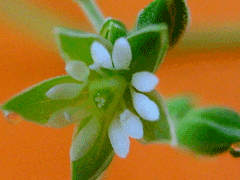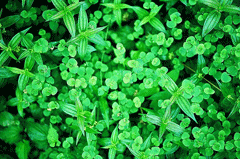 |
|
http://flickr.com/photos/12589168%40N00 |
 |
| http://flickr.com/photos/wwagtail/ |
Translate this page:
Summary
Physical Characteristics

 Drymaria cordata is a ANNUAL/PERENNIAL growing to 0.6 m (2ft). It is in flower from July to August. The species is hermaphrodite (has both male and female organs).
Drymaria cordata is a ANNUAL/PERENNIAL growing to 0.6 m (2ft). It is in flower from July to August. The species is hermaphrodite (has both male and female organs).
Suitable for: light (sandy), medium (loamy) and heavy (clay) soils. Suitable pH: mildly acid, neutral and basic (mildly alkaline) soils. It cannot grow in the shade. It prefers moist soil.
UK Hardiness Map
US Hardiness Map
Synonyms
Plant Habitats
Cultivated Beds;
Edible Uses
Edible Parts: Leaves Shoots
Edible Uses:
Tender young leaves and shoots - raw or cooked as a vegetable[272]. The leaves are used as a salad for their cooling properties[240]. Another report says that the herb is eaten raw or cooked as a stimulant[218].
References More on Edible Uses
Medicinal Uses
Plants For A Future can not take any responsibility for any adverse effects from the use of plants. Always seek advice from a professional before using a plant medicinally.
Antidote Appetizer Depurative Emollient Febrifuge Laxative Stimulant
The pounded leaf is applied to snake bites in China[218]. The plant is appetizer, depurative, emollient, febrifuge, laxative and stimulant[218, 240, 272]. The juice of the plant is used[240].
References More on Medicinal Uses
The Bookshop: Edible Plant Books
Our Latest books on Perennial Plants For Food Forests and Permaculture Gardens in paperback or digital formats.

Edible Tropical Plants
Food Forest Plants for Hotter Conditions: 250+ Plants For Tropical Food Forests & Permaculture Gardens.
More

Edible Temperate Plants
Plants for Your Food Forest: 500 Plants for Temperate Food Forests & Permaculture Gardens.
More

More Books
PFAF have eight books available in paperback and digital formats. Browse the shop for more information.
Shop Now
Other Uses
References More on Other Uses
Cultivation details
Prefers a rather rich soil in full sun[1, 175]. We have very little information on this species and have some doubts about how hardy it is in this country. We assume that it is a perennial plant that can be grown in Britain as a frost-tender annual.
References Carbon Farming Information and Carbon Sequestration Information
Temperature Converter
Type a value in the Celsius field to convert the value to Fahrenheit:
Fahrenheit:
The PFAF Bookshop
Plants For A Future have a number of books available in paperback and digital form. Book titles include Edible Plants, Edible Perennials, Edible Trees,Edible Shrubs, Woodland Gardening, and Temperate Food Forest Plants. Our new book is Food Forest Plants For Hotter Conditions (Tropical and Sub-Tropical).
Shop Now
Plant Propagation
Seed - sow in situ in the spring. Germination usually takes place within 1 - 4 weeks at 20°c[175].
Other Names
If available other names are mentioned here
Native Range
NORTHERN AMERICA: Mexico SOUTHERN AMERICA: Belize, Costa Rica, Guatemala, Honduras, Panama, El Salvador, Brazil, Bolivia, Colombia, Ecuador (Galápagos), Peru, Argentina (Córdoba, Catamarca, Jujuy, La Rioja, Misiones, Salta, Santiago del Estero, Tucumán), Chile, Paraguay (Central, Guairá, Paraguarí), Uruguay
Weed Potential
Right plant wrong place. We are currently updating this section.
Please note that a plant may be invasive in one area but may not in your area so it's worth checking.
Conservation Status
IUCN Red List of Threatened Plants Status :

Growth: S = slow M = medium F = fast. Soil: L = light (sandy) M = medium H = heavy (clay). pH: A = acid N = neutral B = basic (alkaline). Shade: F = full shade S = semi-shade N = no shade. Moisture: D = dry M = Moist We = wet Wa = water.
Now available:
Food Forest Plants for Mediterranean Conditions
350+ Perennial Plants For Mediterranean and Drier Food Forests and Permaculture Gardens.
[Paperback and eBook]
This is the third in Plants For A Future's series of plant guides for food forests tailored to
specific climate zones. Following volumes on temperate and tropical ecosystems, this book focuses
on species suited to Mediterranean conditions—regions with hot, dry summers and cool, wet winters,
often facing the added challenge of climate change.
Read More
Expert comment
Author
(L.)Willd. ex Schult.
Botanical References
58
Links / References
For a list of references used on this page please go here
Readers comment
© 2010, Plants For A Future. Plants For A Future is a charitable company limited by guarantee, registered in England and Wales. Charity No. 1057719, Company No. 3204567.